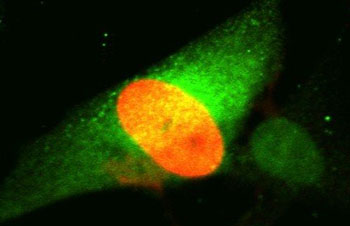RNA Binding Protein Required for Successful Infection by HCMV
By LabMedica International staff writers
Posted on 03 Nov 2016
A team of molecular virologists has catalogued the interactions that occur at the genetic level when cytomegalovirus (HCMV) infects human cells.Posted on 03 Nov 2016
Investigators at the University of California, San Diego (USA) performed comprehensive transcriptome-wide analyses to better understand interactions occurring at the post-transcriptional level between the human host and HCMV.

Image: Human CPEB1 protein is shown here in green, while cytomegalovirus (HCMV) is orange (Photo courtesy of the University of California, San Diego).
They reported in the October 24, 2016, online edition of the journal Nature Structural and Molecular Biology that the host RNA-binding protein CPEB1 (Cytoplasmic polyadenylation element-binding protein 1) was highly induced after infection. Introduction of CPEB1 into uninfected cells recapitulated the infection-related post-transcriptional changes seen in host cells that had been invaded by HCMV.
CPEB1 was also required for poly(A)-tail lengthening of viral RNAs important for productive infection. Furthermore, depletion of CPEB1 reversed infection-related cytopathology and post-transcriptional changes, and decreased productive HCMV titers.
“We found that CPEB1, one of a family of hundreds of RNA-binding proteins in the human genome, is important for establishing productive cytomegalovirus infections,” said senior author Dr. Gene Yeo, professor of cellular and molecular medicine at the University of California, San Diego. “The next steps are to determine the therapeutic value of inhibiting CPEB1 in HCMV infections and identify other RNA-binding proteins that may be important in other viral infections.”
Related Links:
University of California, San Diego










 (3) (1).png)


